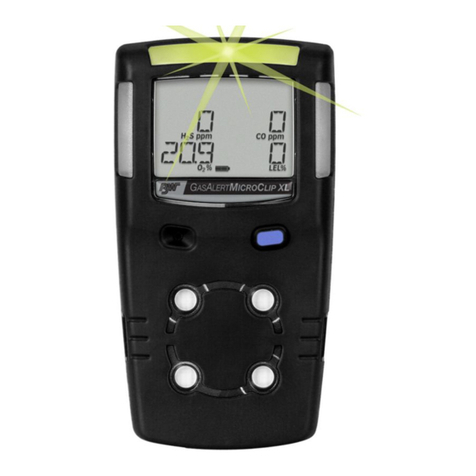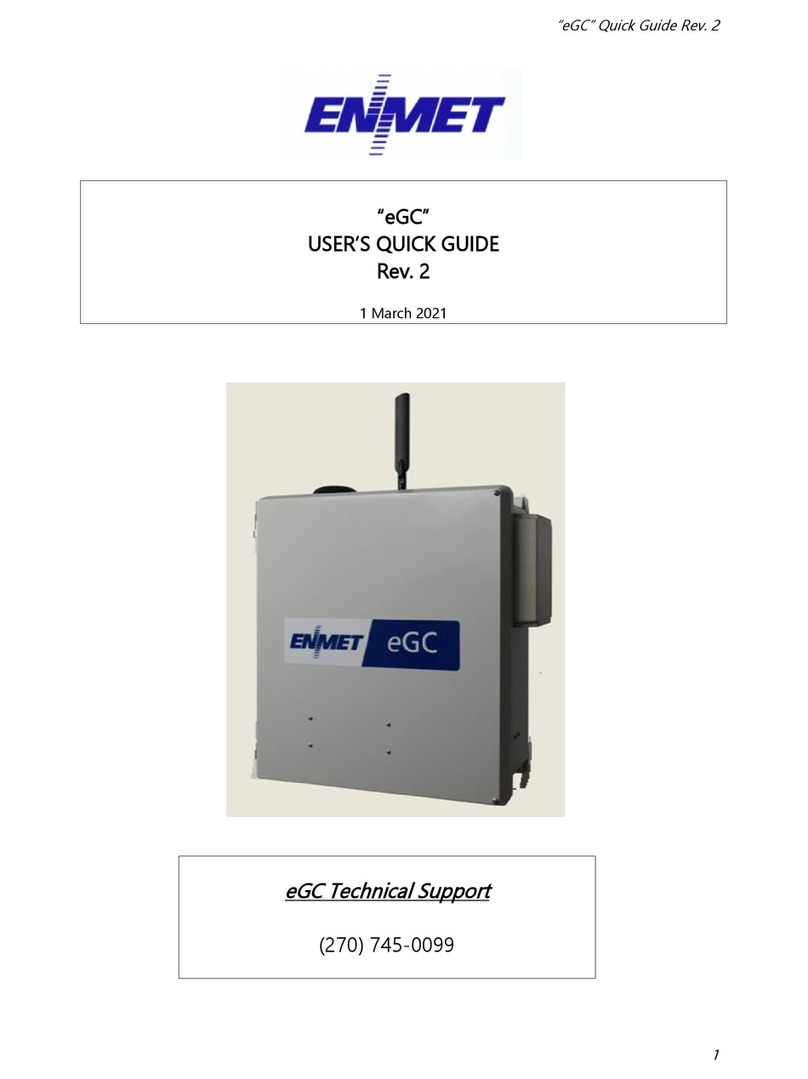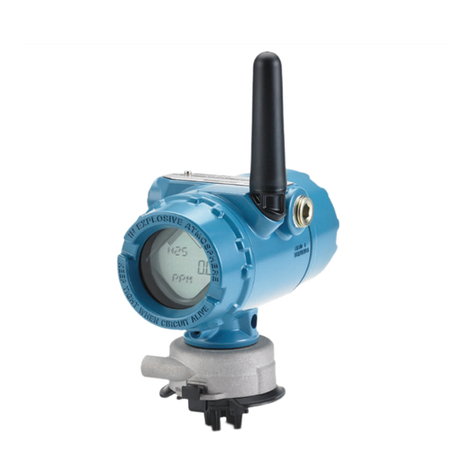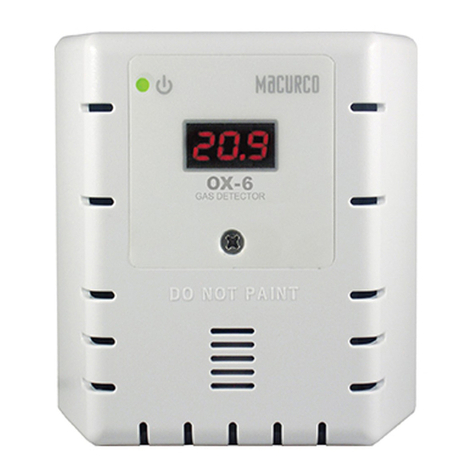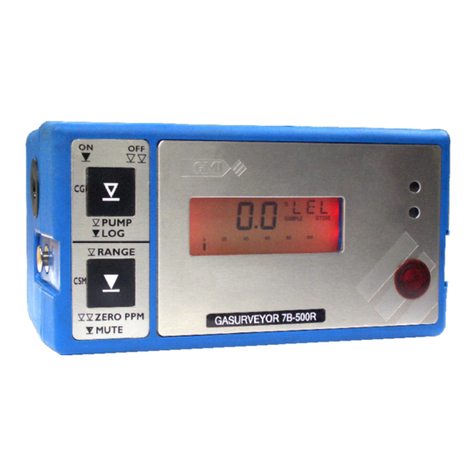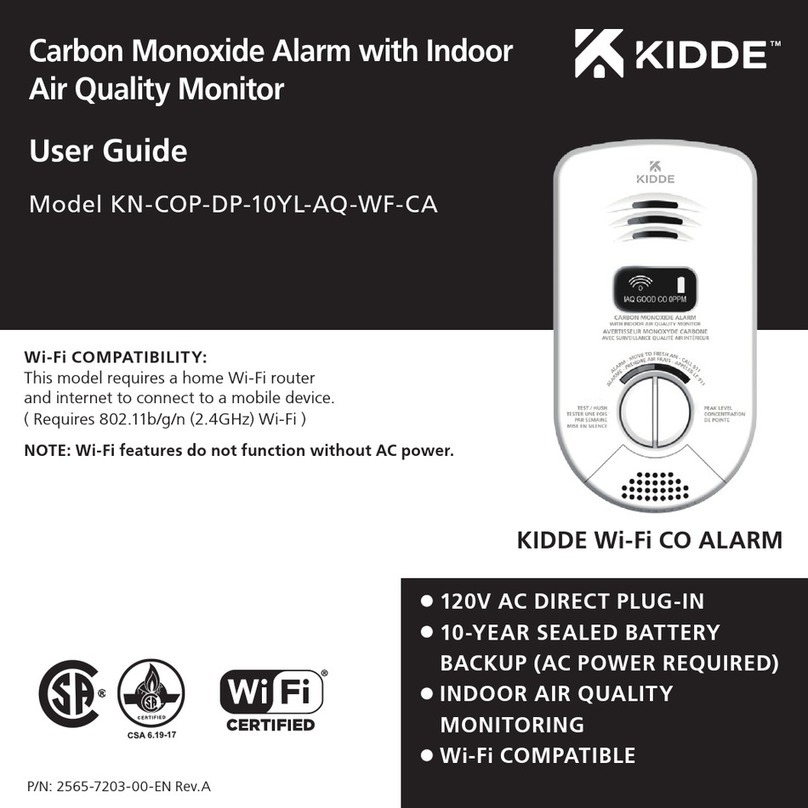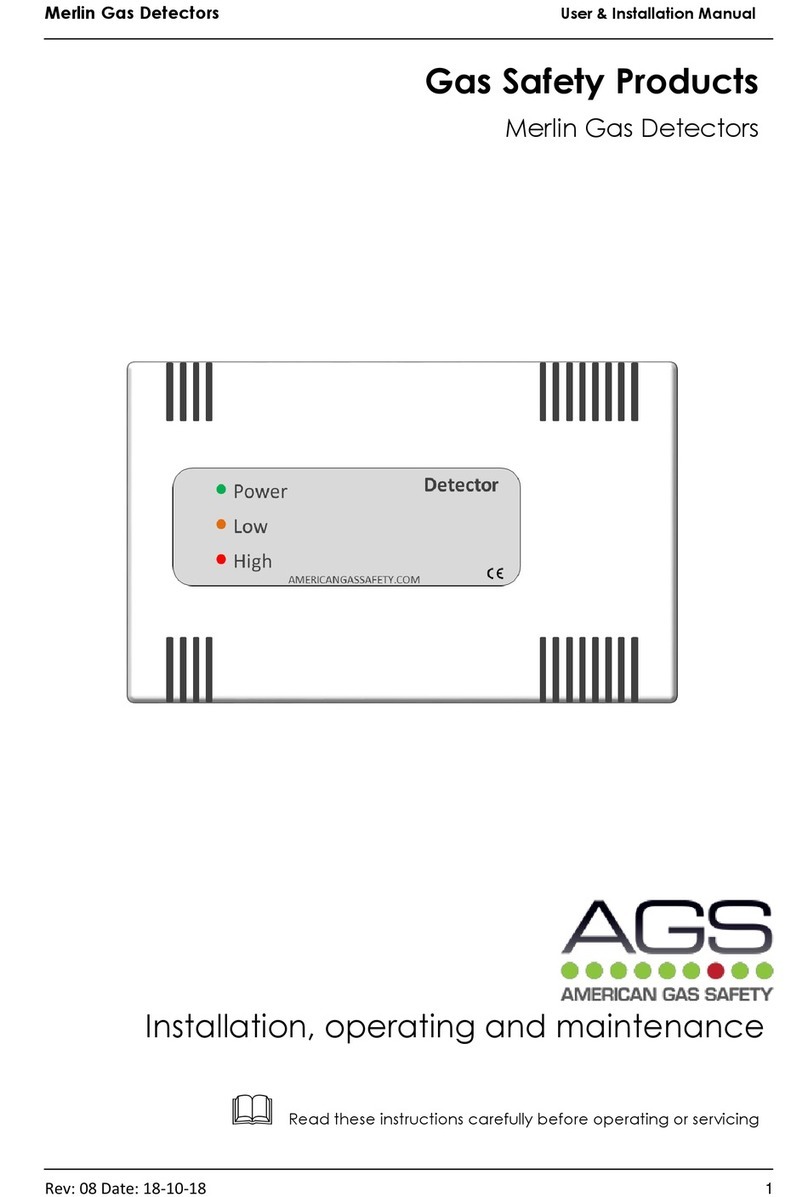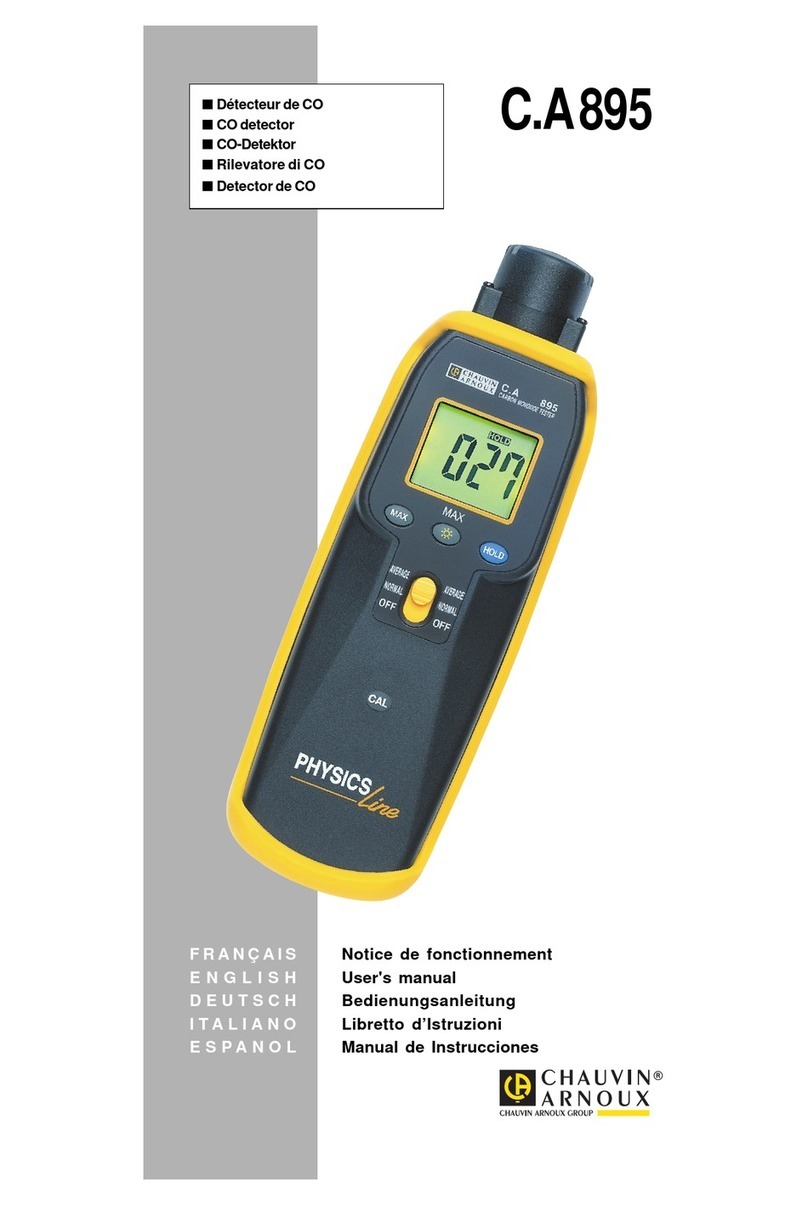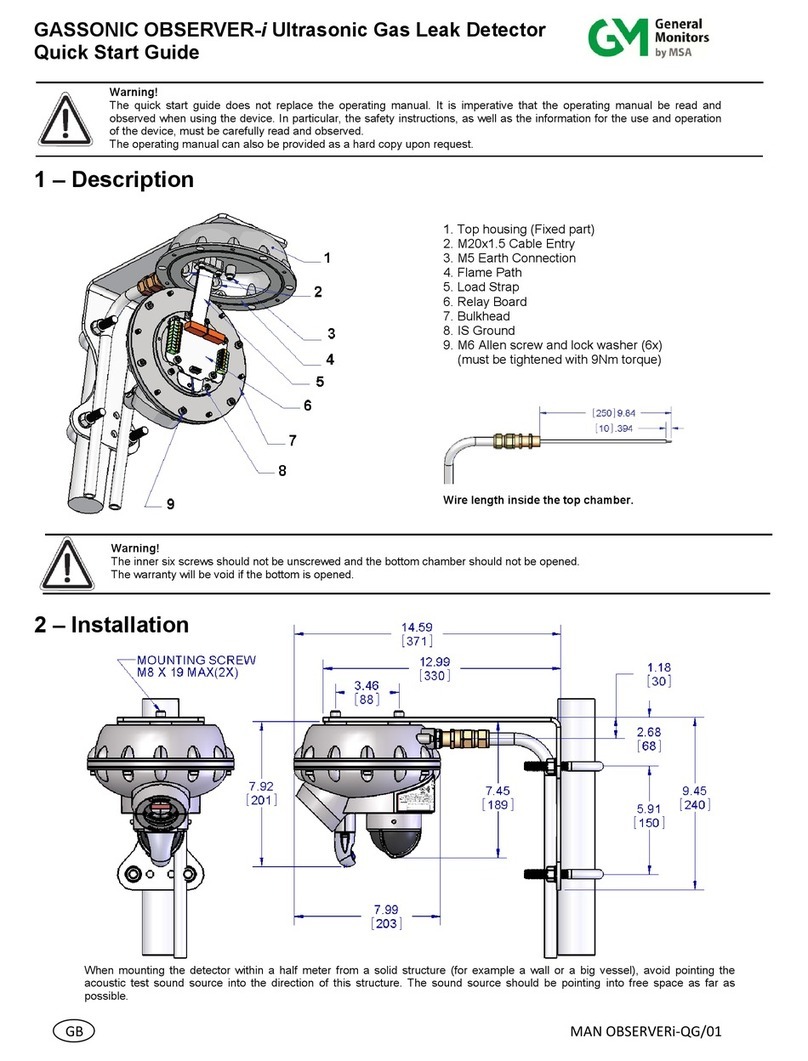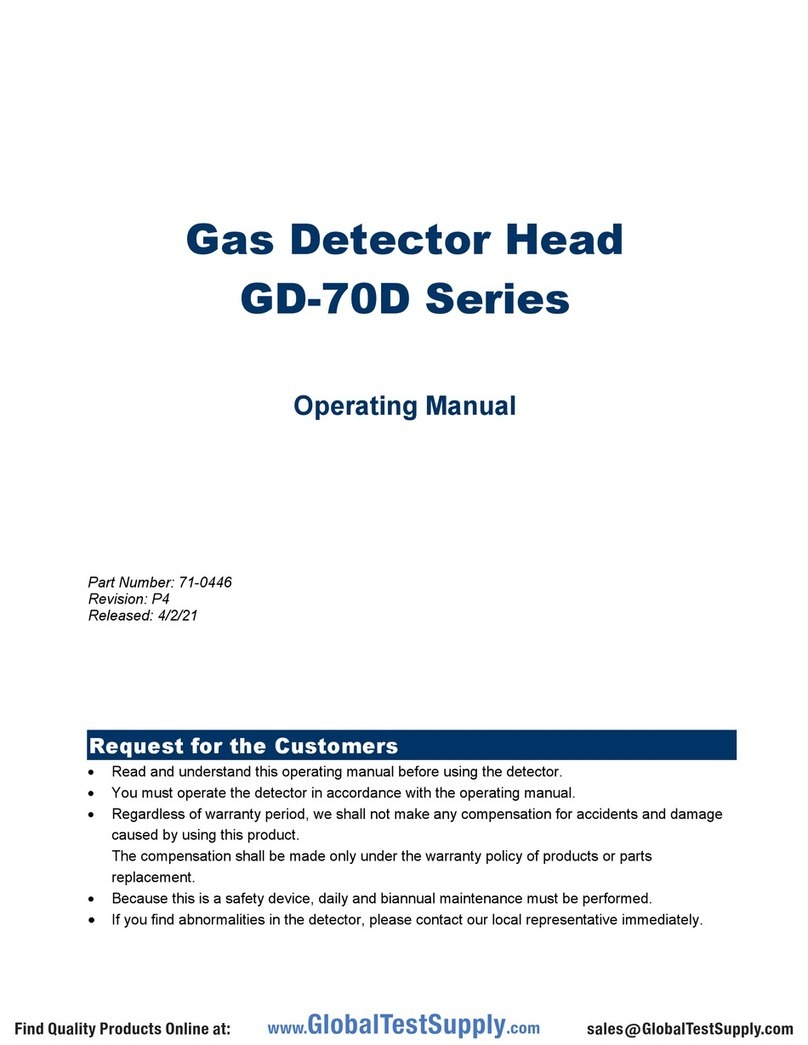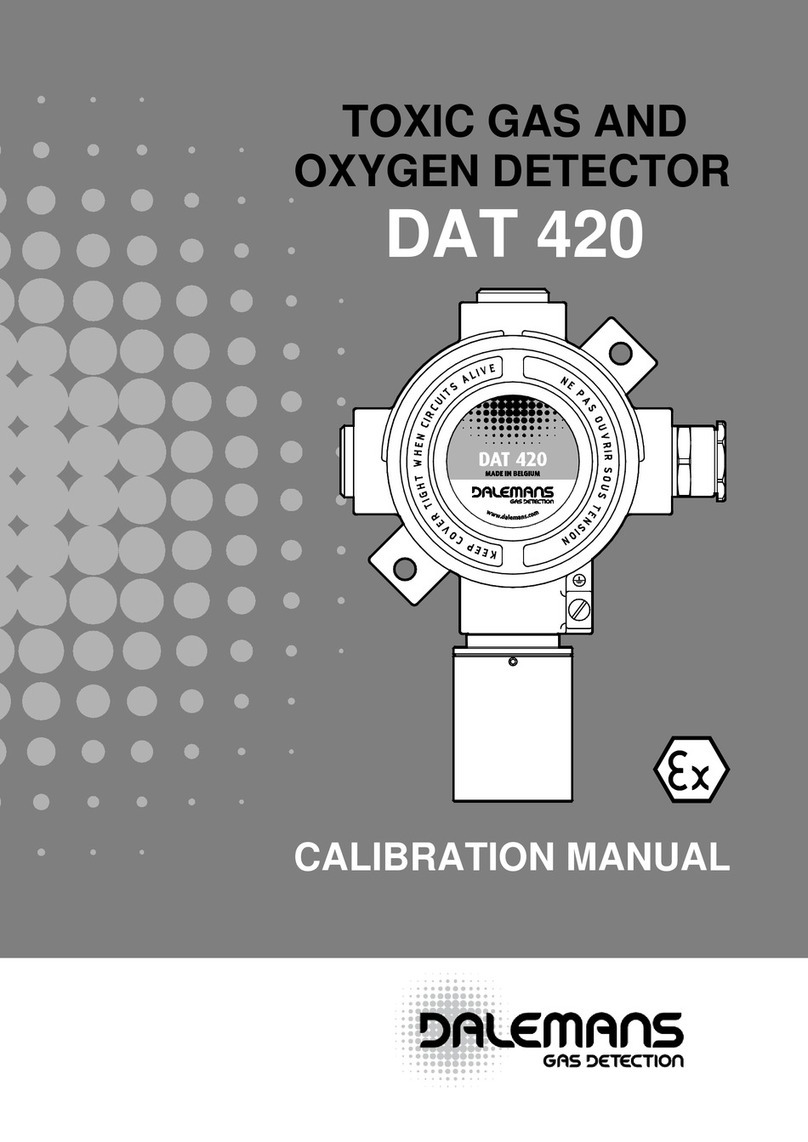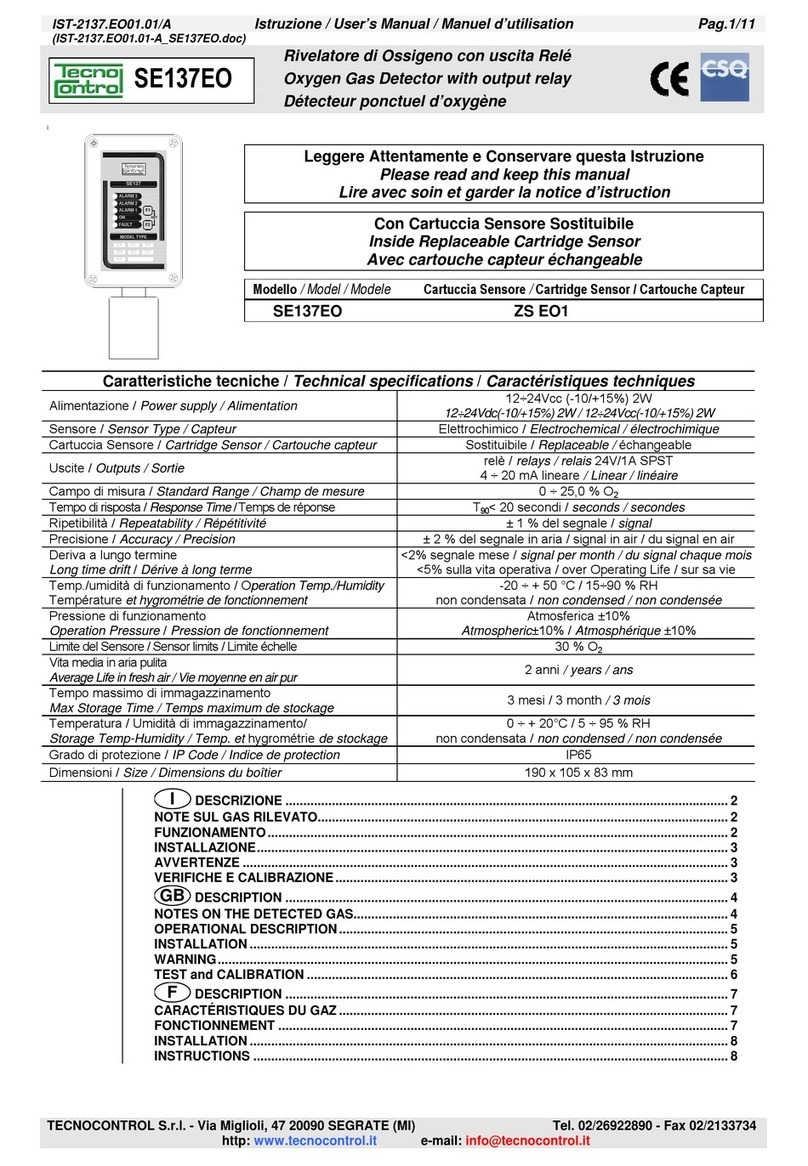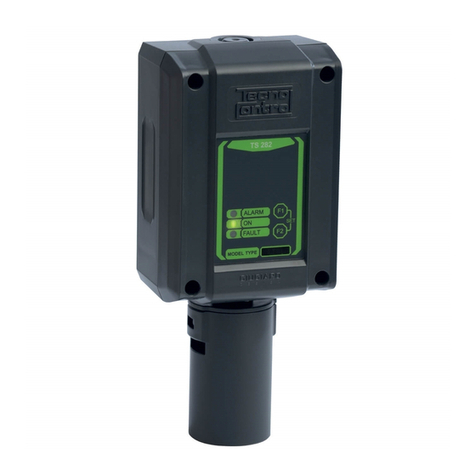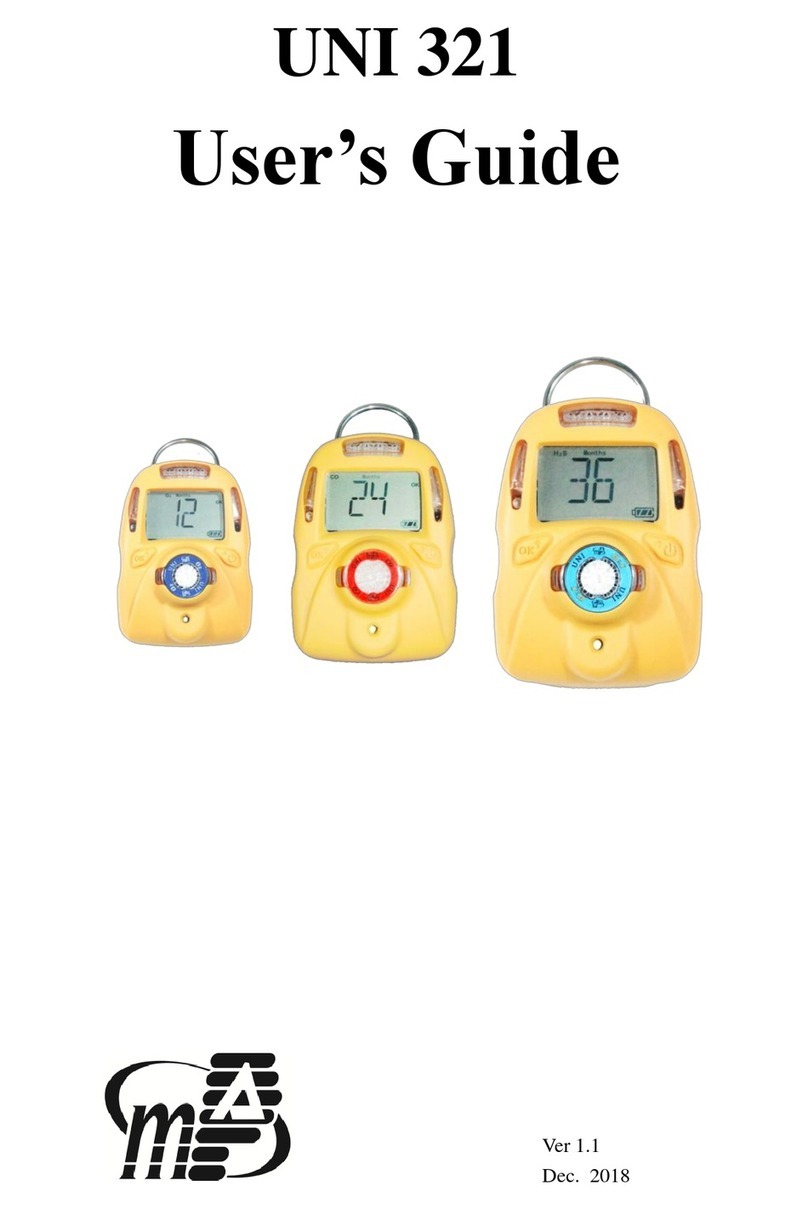Madur IRMA User manual

www.madur.com
CONTENTS
1. BASIC CHARACTERISTICS OF IRMA SENSOR.........................................................3
1.1. SENSOR'S CONNECTORS.............................................................................................................. 5
1.1.1. Power connector (#1)................................................................................................................. 5
1.1.2. Valve and RS485 connector (#2)............................................................................................. 5
1.1.3. I2C connector (#3)..................................................................................................................... 6
1.1.4. Analogue output connector (#4)...............................................................................................7
1.1.5. Serial interface TTL connector (#5)............................................................................................7
1.1.6. Data-logger connector (#6)........................................................................................................ 7
1.2. MADUR.EXE PC PROGRAM............................................................................................................ 8
1.3. ZEROING OF IRMA SENSOR........................................................................................................... 8
1.4. IRMA WORK PHASES...................................................................................................................... 9
1.4.1. Initial pha e – Warming............................................................................................................ 9
1.4.2. Initial pha e – Fir tZeroing....................................................................................................... 9
1.4.3. E ential pha e – Ventilation................................................................................................. 10
1.4.4. E ential pha e – Infu ion....................................................................................................... 10
1.4.5. E ential pha e – Mea urement............................................................................................ 10
1.4.6. E ential pha e – Pre tandby and Standby...........................................................................10
IRMA
MANUAL – VERSION 1.0 1/31

www.madur.com
1.5. IRMA WORK MODES...................................................................................................................... 11
1.5.1. Work cycle................................................................................................................................ 11
1.5.2. Cyclic mea urement ............................................................................................................... 11
1.5.2.1. Cyclic mode (regular) – behaviour of the unit after turning on....................................................................................12
1.5.2.2. Cyclic mode (regular) – unit' behaviour at midnight..................................................................................................13
1.5.3. Mea urement according to cheduler....................................................................................13
1.5.3.1. Mea urement according to cheduler – behaviour of unit after turning on...............................................................14
1.5.3.2. Mea urement according to cheduler – behaviour of unit at midnight......................................................................14
1.5.4. Mea urement triggered by a digital input...............................................................................14
1.5.4.1. Mea urement triggered by a digital input – behaviour of unit after turning on..........................................................15
1.5.4.2. Mea urement triggered by a digital input – behaviour of unit at midnight.................................................................16
1.5.5. Monthly-cyclic mode................................................................................................................ 16
1.5.5.1. Monthly-cyclic mode – behaviour of unit after turning on............................................................................................16
1.5.5.2. Monthly-cyclic mode – behaviour of unit in the different-length month .....................................................................16
1.5.6. Monthly-cyclic mode with adju table length (1-30 day )..........................................................16
1.5.6.1. Monthly-cyclic mode with adju table length – behaviour of unit after turning on........................................................17
1.6. RESTRICTIONS WHEN USING LONG-TERM WORK MODES.....................................................17
2. ADDITIONAL EQUIPMENT OF IRMA SENSOR.........................................................18
2.1. DATA-LOGGER............................................................................................................................... 18
2.1.1.1. Type of acceptable SD card .......................................................................................................................................20
2.1.1.2. Card' file y tem and maximum memory capacity....................................................................................................20
2.1.1.3. Starting/ topping torage to SD card..........................................................................................................................20
2.1.1.4. In erting SD card into data-logger...............................................................................................................................20
2.1.1.5. Ejecting the SD card from data-logger........................................................................................................................20
2.1.1.6. Powering down the en or when torage i in progre .............................................................................................21
2.1.1.7. Turning on the en or with the SD card in data-logger...............................................................................................21
2.1.1.8. Formatting a SD card in the IRma en or...................................................................................................................21
2.1.1.9. Storing mea urement data on SD card.......................................................................................................................21
2.1.1.10. Po ible fla h equence in data-logger module......................................................................................................22
2.1.1.11. SD card error ............................................................................................................................................................22
2.2. LED DISPLAY.................................................................................................................................. 23
2.3. LCD.................................................................................................................................................. 24
2.4. WORK KNOB................................................................................................................................... 25
2.4.1.1. Po ition “Ventilation”....................................................................................................................................................26
2.4.1.2. Po ition “Standby”.......................................................................................................................................................26
2.4.1.3. Po ition “Mea urement”..............................................................................................................................................27
2.4.1.4. Po ition “Auto”.............................................................................................................................................................27
2.4.1.5. Sen or' behaviour with work knob after power up.....................................................................................................27
2.4.1.6. Changing the knob' po ition......................................................................................................................................27
2.4.1.7. Work knob montage.....................................................................................................................................................28
2.5. ADAPTER USB↔SERIAL TTL TO PROGRAM SENSOR'S PROCESSOR....................................29
3. LOADING NEW FIRMWARE TO SENSOR'S MEMORY.............................................29
IRMA
MANUAL – VERSION 1.0 2/31

www.madur.com
1. BASIC CHARACTERISTICS OF IRMA SENSOR
•IRma i an optical en or for ga detection.
•It ha a wide work autonomy. It ha implemented few automatic mea urement mode that allow to
adju t how the en or work to own requirement .
•IRma i an infra-red en or – it incorporate a monochromatic pectral line from the near infra-red part of
pectrum.
•It i produced a one channel en or. Optionally it can be prepared in two-channel ver ion.
•It i factory calibrated – multipoint calibration with reference ga e – what provide high accuracy of
mea urement re ult .
•It ha built-in temperature en or. It i al o thermally calibrated (al o multipoint temperature calibration)
what provide preci e compen ation for thermal drift.
•It can optionally be equipped with atmo pheric pre ure en or that provide compen ation for the
change of pre ure.
•It ha one current analogue output (0/4÷20mA) and one voltage analogue output (0÷5/10V). Output'
re olution i 12bit .
•It ha two trong “open-drain” type output that allow to teer external load like pump , valve , relay ,
etc.
•It require +24VDC upply. It accept upply in range 14÷40VDC
•It ha four digital input that allow to control the en or' work
•It ha four digital output that can ignali e the current mea urement tatu and/or control external
device .
•It ha PWM output with TTL ignal level that can be u ed for e.g. teering the internal ga pump
•It ha a built-in RTC clock with calendar. RTC ha a replaceable battery that provide clock'
uninterrupted work even at power decay.
•It ha built-in erial interface with TTL ignal level that allow to read the re ult in digital form and/or to
adju t en or' etting from madur.exe PC program and to upgrade en or' firmware.
•Optionally it can be equipped with RS485 level interface and MODBUS communication that allow to
imultaneou ly connect everal en or to a common communication bu .
•It allow to connect data-logger for con tant torage of mea urement re ult . Thi optional data-logger
incorporate full ize SD card .
•It ha 4-pin connector to connect external device with I2C bu .
•It can be optionally be equipped with 4.5 digit LCD without di play (digit height 12mm) and/or with red
LED di play (with digit height 25mm – vi ible from long di tance ). Di play i connected via I2C bu .
Di play are optional equipment.
•It can be quipped with optional work mode knob that allow to manually elect the work pha e (manual
override over programmed mode )
IRMA
MANUAL – VERSION 1.0 3/31

www.madur.com
Drawing 1. Block diagram of IRma sensor

www.madur.com
1.1. Sensor's connectors
Layout of all the connector of IRma en or, CHF3 ver ion are howed in Drawing 1.
Pin layout i pre ented in the Table 1.
Drawing 2. Connectors on IRma board
Signature on the drawing
1. Power connector (#1)
2. Valve and RS485 connector (#2)
3. I2C connector (#3)
4. Analogue output connector (#4)
5. Serial interface TTL connector (#5)
6. Data-logger connector (#6)
1.1.1. Power connector (#1)
Thi i where external +24VDC power upply i connected. IRma en or accept upply in range 14÷40VDC. It i
advi ed to u e nominal upply. Power connector i eparable. IRma i provided with matching plug where upply
cable can be connected. Sen or' circuit i protected again t rever e polarity with a diode.
Sen or' power con umption (without the additional equipment), at +24VDC upply voltage doe not exceed
100mA.
It i advi ed to u e tabili ed power upplie with power efficiency not lower than 2000mA.
1.1.2. Valves and RS485 connector (#2)
Valve connector allow to connect external device of higher power con umption, i.e. electromagnetic valve .
Thi connector al o allow to connect RS-485 communication interface.
Below we pre ent a diagram of control circuit of valve connected to connector (#2). Steering tran i tor work in
“open drain” mode. Connector' terminal al o contain upply (+12V or +24VDC), that can be incorporated to
power the connected valve . Supply connector are, by default, et to +12VDC. Suppre ion diode allow to
connect inductive load .
The maximal current that can be con umed from valve connector (+12V or +24V pin ) i 500mA (in total for both
upply pin ).
The maximal current that the control tran i tor accept i 1A (for each tran i tor).
IRMA
MANUAL – VERSION 1.0 5/31

www.madur.com
The maximal voltage that control tran i tor turn off i 30V.
If the connected load i inductive and doe not incorporate upply +12V/+24V it i nece ary to provide eternal
uppre ion diode or/and uppre ion capacitor .
Pin 1 and 2 of the ame connector are u ed for RS485 communication interface – thi interface i an optional
equipment.
Drawing 3. Valves' control circuit incor orated in IRma sensor
1.1.3. I2C connector (#3)
I2C connector allow to connect external equipment to the en or that i controlled via I 2C bu , i.e. LED di play
or/and LCD di play or/and work knob. De cription of the additional equipment can be found in the annexe to thi
manual. Connector allow to connect up to 4 additional equipment . Connector along the I2C bu provide +12V
upply for the connected module .
The following module are connected parallel to connector #3.
The maximal current that can con umed from I2C connector (from +12V pin) i 500mA.
IRMA
MANUAL – VERSION 1.0 6/31

www.madur.com
1.1.4. Analo ue outputs connector (#4)
Analogue output connector provide both channel of analogue output , i.e. current output and voltage one.
Analogue output' GND i at the ame potential a upply' GND.
The minimal re i tance that can load the voltage output U1 i 1.000 Ω (for range 0÷5V) or 10.000 Ω (for range
0÷10V).
The maximal re i tance that can load the current output I1 i 300 Ω.
1.1.5. Serial interface TTL connector (#5)
Serial interface connector allow to communicate with en or in digital form (with help of madur.exe PC program)
but al o allow to program microproce or' memory (firmware upgrade). Communication i performed at TTL
level . To connect en or to PC a pecial adapter i required (available from madur). Connector provide #PSEN
terminal that allow to et micro-controller in the programmable mode – thi pin hould be hort-circuit to GND
when en or i powered on.
Detailed in truction on firmware upgrade i provided in the chapter Loading new firmware to sensor's memory.
1.1.6. Data-lo er connector (#6)
Connector allow to connect optional data-logger module available from madur. Connector provide all the
ignal required by data-logger including +5V upply. Data-logger i delivered with ribbon cable and a plug
matching connector #6.
Table 1. Pin layout for each connector.
# Dr wing Pin l yout Connector type
1
1. +24VDC – upply (input)
2. GND – upply ground
Phoenix Contact:
MSTBVA 2,5/2-G-5.08
MSTB 2,5/ 2-ST-5,08
2
1. RS485 A
2. RS485 B
3. Valve 2 “-“ – open drain output
4. +12VDC (or +24VDC) – output
5. Valve 1 “-“ – open drain output
6. +12VDC (or +24VDC) – output
Phoenix Contact:
3 x MKDS 1/ 2-3,81
3
1. +12V – output
2. SDA – I2C
3. SCL – I2C
4. GND
Phoenix Contact:
MCV 1,5/ 4-G-3,5
IRMA
MANUAL – VERSION 1.0 7/31

www.madur.com
4
1. I1 “+” – I1 analogue output
2. GND
3. U1 “+” – U1 analogue output
4. GND
Phoenix Contact:
2 x MKDS 1/ 2-3,81
5
1. RxD TTL – data input
2. TxD TTL – data output
3. GND
4. #PSEN
Micromatch 4
6
1. MOSI
2. VCC (+5V)
3. MISO
4. LEDMMC
5. SCLOCK
6. SWITCHMMC
7. CSLOG
8. ISLOG
9. GND
10. GND
Micromatch 10
1.2. madur.exe PC pro ram
madur.exe i PC program that work in Micro oft Window operating y tem . It i provided by madur,
free-of-charge with every delivered en or. Program i not e ential to work with the en or after it in tallation,
but it help in comfortable adju tment of en or' etting or in diagno ing of en or' tatu . Detailed de cription
of program' function can be found in a eparate manual.
1.3. Zeroin of IRma sensor
A any other electronic mea urement device, IRma en or i a ubject to a variou drift – mainly thermal and
time drift . Sen or i equipped with temperature en or that allow to compen ate the effect of temperature
change to the mea urement . Time drift derive mainly from the phy ical change of the en or' optical
y tem. Time drift are removed with the zeroing proce .
Zeroing con i t in thorough ventilation of en or' ga path with neutral ga (clean ambient air, nitrogen, etc.)
and later in noting the ignal level to the corre ponding mea ured zero ga . It i advi ed to ventilate the en or
for at lea t 5 minute .
To minimi e the time drift effect it i advi ed to zero the en or a often a po ible.
IRMA
MANUAL – VERSION 1.0 8/31

www.madur.com
1.4. IRma work phases
The e are the work pha e IRma en or can be in:
1. Initial pha e , occur ju t one time, after the en or i powered on:
•“Warming” pha e – initial warming up of en or' electronic
•“Fir tZeroing” pha e – the initial zeroing of en or
2. E ential pha e , occur in all work cycle :
•“Ventilation” pha e – zeroing en or with the neutral ga
•“Mea urement” pha e – actual mea urement
•“Standby” pha e – en or re ting
1.4.1. Initial phases – Warmin
“Warming” pha e occur right after en or i powered on. Sen or perform initial te t of it tatu and wait for
the y tem temperature to tabili e. During thi pha e no u able mea urement are performed. Time for
“Warming” pha e i adju table from the PC program. Madur et thi time to 30 minute .
Di play, on each egment, perform te t and then for hort period how the firmware ver ion of the en or in
format x.y.z. During the re t of the “Warming” di play egment how da he .
Valve , pump control and analogue output act a they were programmed to behave during “Warming” pha e in
PC program.
REMARK: U er can change the time for the “Warming” pha e via madur.exe program. However it i not advi ed
a it can di turb en or' thermal compen ation and in con equence, demote mea urement quality.
1.4.2. Initial phases – FirstZeroin
“Fir tZeroing” pha e occur directly after “Warming”. During thi pha e en or mu t be provided with neutral ga
a it perform zeroing. During thi pha e no u able mea urement are performed, but en or mea ure and
how the re ult on the di play. Value on di play fla h. Time of “Fir tZeroing” pha e i the ame a for
“Ventilation” pha e and it i adju table from the PC program. Madur et thi time to 15 minute .
Valve , pump control and analogue output act a they were programmed to behave during “Ventilation” pha e in
PC program.
Storage to SD card i performed, if thi option i enabled.
REMARK: U er can change the time of “Fir tZeroing” pha e by changing the length of the ”Ventilation” pha e in
the PC program. It i advi ed not to horten thi time below 5 minute – in ca e there i a ub tantial dead
volume connected to the en or that may not be ventilated properly, and in con equence may cau e inaccurate
mea urement .
IRMA
MANUAL – VERSION 1.0 9/31

www.madur.com
1.4.3. Essential phases – Ventilation
“Ventilation” pha e tart each mea urement cycle. During “Ventilation” en or i provided with neutral ga and
perform zeroing. During thi pha e no u able mea urement are performed, but en or mea ure and how
the re ult on the di play. “Ventilation” time i et in the PC program madur.exe. By default it i et to 15 minute .
It i advi ed not to et it below 5 min.
Valve , pump control and analogue output act a they were programmed to behave during “Ventilation” pha e in
PC program.
REMARK: The fir t work cycle that occur after the initial pha e (after en or i powered on) doe not tart with
“Ventilation” pha e but at once with the “Mea urement” pha e. It i becau e zeroing of en or wa ju t performed
during the “Fir tZeroing” pha e.
1.4.4. Essential phase – Infusion
The “Infu ion” pha e precede directly the “Mea urement ”. During infu ion the en or i upplied with
mea urement ga and perform mea urement but due to the delay cau ed by the ga cour e and the en or'
reaction time the mea urement re ult can be underrated. Di play behaviour i identical to “Ventilation” pha e.
Duration of infu ion i con tant and equal 1 minute.
1.4.5. Essential phases – Measurement
“Mea urement” i the main pha e for every work cycle. It occur right after the “Ventilation”. During thi pha e,
en or i provided with the mea ured ga and perform u able mea urement . Re ult are pre ented on di play.
Time of the “Mea urement” pha e depend on the elected work mode and can la t from a dozen of minute up
to 31 day . Thi time i adju table from madur.exe PC program. By default it i et to 6 hour .
Valve , pump control and analogue output act a they were programmed to behave during “Mea urement”
pha e in PC program.
Storage to SD card i performed, if thi option i enabled.
1.4.6. Essential phases – Prestandby and Standby
“Pre tandby” and a follow-up “Standby” pha e occur after every “Mea urement” pha e if the “Mea urement”
pha e ha fini hed, but a new work cycle ha not yet tarted. Tho e pha e may not occur at all. Purpo e of
“Pre tandby” pha e i to ventilate ga channel and remove any re idue of mea ure ga . Thi pha e la t for two
minute and i not adju table.
“Standby” occur directly after “Pre tandby” and i when en or imply re t. “Standby” time i not defined, en or
tay in thi pha e until a new work cycle begin .
During the e pha e no u able mea urement are performed, di play how a ingle da h.
Valve , pump control and analogue output act a they were programmed to behave individually during “Standby”
and “Pre tandby” pha e .
Storage to SD card i performed, if thi option i enabled.
IRMA
MANUAL – VERSION 1.0 10/31

www.madur.com
1.5. IRma work modes
IRma en or can work according to everal predefined program . Tho e automatic program are called work
mode . There are available:
•Cyclic mea urement
•Mea urement according to cheduler
•Mea urement triggered by a digital input
•Monthly-cyclic mode
•Monthly-cyclic mode with adju table length (1-30 day )
1.5.1. Work cycle
Every work mode i divided into work cycle . Work cycle tart with “Ventilation” pha e and after that with
“Mea urement” pha e. After “Mea urement”, if it i not yet a time to tart a new work cycle, en or goe to
“Pre tandby” and then to “Standby” pha e. Sen or tay in “Standby” until a new work cycle begin .
1.5.2. Cyclic measurements
Cyclic mode i a imple-one-day mode, i.e. it occur identically each day and con i t of the con equent ame
work cycle . Cyclic mea urement mode ha the following parameter (every of tho e i adju table from the
madur.exe PC program):
•Moment of the fir t zeroing H1- thi i when the fir t work cycle tart . Thi i et with 1 accuracy.
•Time of the “Ventilation” pha e TV
•Time of the “Mea urement” pha e TM
•Time of the entire work cycle TC
Madur deliver en or in cyclic mode with the following default etting :
H1 00:00:00 the fir t cycle tart each day at midnight
TV 00:15:00 (15 minute )
TM 06:00:00 (6 hour )
TC 06:00:00 (6 hour )
H1 and TC parameter et the beginning time for each cycle during the day. By default there are 4 cycle a day
tarting at the following time :
H1 00:00:00 the fir t cycle tart each day at midnight
H2 06:00:00 the econd cycle
H3 12:00:00 the third cycle
H4 18:00:00 the fourth cycle
H1 00:00:00 the fir t cycle the next day
…...
A hown above, by default, the Standby pha e doe not occur.
IRMA
MANUAL – VERSION 1.0 11/31

www.madur.com
REMARK: the beginning of the new cycle ha a higher priority than any current cycle pha e. Thi mean that if
the beginning of the new cycle occur before the current cycle fini he the current pha e will be interrupted and
the device will tart a new cycle.
Below, we how the example of what the mea urement will look like through the day for the default and ome
other example etting .
Drawing 4. Cyclic mode
TC – cycle time
TM – mea urement time
TW – warming time
TV – ventilation time
1.5.2.1. Cyclic mode (re ular) – behaviour of the unit after turnin on
The device et in the regular cyclic mode execute the initial pha e - “Warming” and “Fir tZeroing” - and then
proceed directly to the “Mea urement ”. A can be een below, duration of the fir t cycle i a ynchronou to all
the following, normally planned cycle . The ynchronization tart with the econd cycle.
See what the work cycle look like if the en or with default etting i turned on at 3 o'clock (H0). The
mea urement are interrupted with the next, planned cycle H2 ( tarting with ventilation pha e). Then it work a
planned: →H3→H4→H1→H2...
IRMA
MANUAL – VERSION 1.0 12/31

www.madur.com
Drawing 5. Regular cyclic mode – sensor turned on at 3.00AM, TM + TV>TC
TC – cycle time
TM – mea urement time
TW – warming time
TV – ventilation time
H0 – moment when en or wa powered on
H1÷H4 – beginning of the following work cycle
Drawing 6. Regular cyclic mode – sensor turned on at 3.00AM, TM + TV<TC
The mea urement together with the ventilation pha e are horter than a ingle cycle length. The en or await
the following cycle in Standby pha e.
1.5.2.2. Cyclic mode (re ular) – unit's behaviour at midni ht
The la ting cycle will not be interrupted at midnight. The current cycle will normally be fini hed and the device will
move on to the “Standby” pha e awaiting the H1 moment. If the H1 (fir t zeroing) moment come while the
previou cycle la t , the current cycle will be interrupted and a new cycle will begin.
1.5.3. Measurements accordin to scheduler
Mea urement according to cheduler i al o a 24-hour mode (repeat every 24-hour ) and contain of the
maximum of 24 mea urement cycle . Each of the cycle' beginning point i defined individually. Mea urement
according to cheduler are defined by the below parameter (they can be et via madur.exe program):
•Cycle activation table – inform which of the cycle (H1..H24) are to be performed
•Table of the beginning point for all cycle H1..H24 – inform what time every day the pecific
mea urement cycle tart
•The length of the “Ventilation” pha e TV
•The length of the „Mea urement” pha e TM
•The length of the whole cycle TC
•H0 – moment when en or i powered on
REMARK: the beginning of a new cycle ha a higher priority than any current cycle pha e. Thi mean that if the
beginning of the new cycle occur before the current cycle fini he the current pha e will be interrupted and the
device will tart the new cycle.
IRMA
MANUAL – VERSION 1.0 13/31

www.madur.com
Below we how mea urement cycle of the 24-hour period for the example etting of the mea urement
according to cheduler mode.
Drawing 7. Measurements according to scheduler mode
In the exam le above there are two work hases set
during the day: H1 begins at 6:00, H2 begins at 18:15.
Because TC < TV + TM sensor goes into standby
mode in between cycles.
1.5.3.1. Measurements accordin to scheduler – behaviour of unit after turnin on
After the device et to Measurements according to scheduler mode i turned on, it perform the initial pha e ,
that i „Warming” and „Fir tZeroing” and then proceed directly to „Mea urement”. A hown below the fir t cycle
duration i a ynchronou to all the following, normally planned cycle . The ynchronization tart with the econd
cycle.
See the work cycle if the en or ha been turned on at 6 o'clock (H0)
Drawing 8. Measurements according to scheduler mode – sensor turned on at 6.00AM
In the exam le above, sensor is turned on H0, in
between scheduled cycles H1 and H2. Sensor begins
its work with the initial hases (Warming and
FirstZeroing) and then roceeds with the
measurements. Sensor synchronise its work (to the
scheduler) with the beginning of the first rogrammed
work cycle (H2).
1.5.3.2. Measurements accordin to scheduler – behaviour of unit at midni ht
The la ting cycle will not be interrupted at midnight. The current cycle will normally be fini hed and the device will
move on to the “Standby” pha e awaiting the fir t planned cycle (H1 or next if H1 i inactive). If the H1 (or next if
H1 i inactive) moment come while the previou cycle la t , the current cycle will be interrupted and a new cycle
will begin.
1.5.4. Measurements tri ered by a di ital input
For the mea urement triggered by a digital input there are no predefined beginning point of the cycle . The
beginning of each of the cycle i triggered from the out ide with help of any of the digital input In1..In4.
IRMA
MANUAL – VERSION 1.0 14/31

www.madur.com
The ri ing lope appearing on the active input i the trigger. The di connected (floating) input i treated a
remaining in a high tate.
Mea urement triggered by a digital input ha following parameter (all the parameter can be et via madur.exe
program):
•Activation of triggering input – define which of thee input (In1..In4) can trigger the mea urement cycle
•The length of the “Ventilation” pha e TV
•The length of the „Mea urement” pha e TM
•The length of the whole cycle TC
•H0 – moment when en or i powered on
RAMARK: triggering ignal coming from any of the active input ha a higher priority than the current cycle pha e.
Thi mean that each time a triggering lope appear it interrupt the current pha e and the device tart the new
cycle.
An example of the cycle for the 24-hour period in a triggered mode (for a pecific etting ) i hown below.
Drawing 9. Measurements triggered by a digital in ut, TV + TM <TC
In the above exam le two cycles were evoked. At 6:14
(In1) and 14:20 (In2). After the In1 measurement cycle
has finished the sensor moved on to Standby hase
awaiting the In2 signal which triggers another
measurement cycle beginning.
1.5.4.1. Measurements tri ered by a di ital input – behaviour of unit after turnin on
After the device, et to Measurements triggered by a digital in ut mode, i turned on it perform the initial pha e ,
that i „Warming” and „Fir tZeroing” and then proceed directly to „Mea urement”. A hown below the fir t cycle
after the tart-up i performed even though there wa no triggering ignal. After the fir t cycle ha fini hed the
device move on to “Standby” pha e and await for the triggering ignal.
Drawing 10. Measurements triggered by a digital in ut, TV + TM >TC
In the above exam le the beginning of the new cycle
has been triggered at 7:10 (In1) and 8:25 (In2). The
first cycle (after the turn on) has been interru ted by a
signal from In1. In1 cycle has been discontinued as
signal from In2 a eared.
IRMA
MANUAL – VERSION 1.0 15/31

www.madur.com
1.5.4.2. Measurements tri ered by a di ital input – behaviour of unit at midni ht
Midnight doe not interrupt the current cycle. The current cycle i normally fini hed and the device proceed to
“Standby” pha e awaiting the triggering ignal from any of the active input .
1.5.5. Monthly-cyclic mode
Monthly-cyclic mode ha a length of the cycle equal to the length of the calendar month. Thi mean the en or
i zeroed once a month, and then a continuou mea urement proceed (until the next zeroing).
Monthly-cyclic mode ha the below parameter (all of them et via madur.exe program):
•Fir t zeroing date (DD/MM/YY) – define the calendar date the fir t zeroing i to be performed. The date
indicate the number of day when the monthly zeroing i to be performed.
•Fir t zeroing moment – it i the exact hour (with the accuracy of 1 – hh:mm: ) the monthly zeroing i to
be performed
•The length of the “Ventilation” pha e TV
1.5.5.1. Monthly-cyclic mode – behaviour of unit after turnin on
After the device et to Monthly mode i turned on it perform the initial pha e , that i „Warming” and
„Fir tZeroing” and then proceed directly to „Mea urement”. It remain in the mea urement pha e until the
another zeroing come .
1.5.5.2. Monthly-cyclic mode – behaviour of unit in the different-len th months
The date of the fir t zeroing indicate when exactly (the day of the month) the zeroing i to be performed. If the
number of the day in a month i maller than the number of the day the zeroing i to be performed on, the
zeroing will be performed on the la t day of the month. That mean , that whenever the date of the fir t zeroing i
et to the 30th of January, the zeroing in February will be performed on the 28th.
1.5.6. Monthly-cyclic mode with adjustable len th (1-30 days)
The Monthly-cyclic mode with adjustable length i imilar to monthly-cyclic mode, however the cycle length doe
not equal the calendar month length but it i a et number of day (1..30).
Monthly-cyclic mode with adju table length ha the below parameter (all of them et via madur.exe program):
•Fir t zeroing date (DD/MM/YY) – define the calendar date the fir t zeroing i to be performed. From
that day on the other zeroing are being et.
•Fir t zeroing moment – it i the exact hour (with the accuracy of 1 – hh:mm: ) the cyclic zeroing i
to be performed
•The length of the cycle – number of day (1..30)
•The length of the “Ventilation” pha e TV
IRMA
MANUAL – VERSION 1.0 16/31

www.madur.com
Example:
The en or work in the adju table monthly mode. The date/hour of the fir t zeroing i 4:00, the 1 t of September.
The cycle length i 7 day . A the 1 t of November 2014 wa Monday the en or will perform zeroing each
Monday at 4:00.
1.5.6.1. Monthly-cyclic mode with adjustable len th – behaviour of unit after turnin
on
After the device et to Monthly adju table mode i turned on it perform the initial pha e , that i „Warming” and
„Fir tZeroing” and then proceed directly to „Mea urement”. It remain in the mea urement pha e until the
another zeroing come .
1.6. Restrictions when usin lon -term work modes
Long-term work mode , e pecially with long cycle time , re ult in long between-zeroing time . That can lower the
mea urement accuracy. In order to obtain high mea urement accuracy it i advi ed to avoid long-term work
mode .
IRMA
MANUAL – VERSION 1.0 17/31

www.madur.com
2. ADDITIONAL EQUIPMENT OF IRMA SENSOR
2.1. Data-lo er
Data-logger module i pre ented in the picture below. It i connected to the Micro-Match 10-pin male connector.
Data-logger tore mea ured re ult onto full ize SD card. It i equipped with blue LED and mono table button.
Drawing 11. SD card data-logger
IRMA
MANUAL – VERSION 1.0 18/31

www.madur.com
Drawing 12. Mounting o enings in the anel
Drawing 13. Data-logger mounting
IRMA
MANUAL – VERSION 1.0 19/31

www.madur.com
2.1.1.1. Type of acceptable SD cards
Data-logger accept full ize SD and SDHC card , MMC card a well. It i po ible to u e both mini and micro
SD card along with a uitable full ize adapter. Card' peed cla i not critical.
Madur ha ucce fully te ted SD card produced by King ton and SanDi k, capacitie 265MB ÷ 2GB. And
SDHC card of the ame manufacturer : 4GB, 8GB, 16GB.
Sen or are delivered with (u ually) 4GB King ton SDHC card with USB adapter.
2.1.1.2. Card's file system and maximum memory capacity
FAT16 file y tem i applied with maximal clu ter ize = 64kB. For thi rea on the card' maximum capacity i
4GB.
REMARK: It i po ible to u e SD card larger than 4GB, but then uch card mu t be formatted in IRma en or.
Sen or format >4GB card u ing FAT16 file y tem. The area above 4GB tay unu ed.
2.1.1.3. Startin /stoppin stora e to SD card.
Storage to SD card may be turned on or off. Turning the torage on/off can be performed from the PC program
madur.exe when en or i connected via erial interface. From thi PC program it i po ible to et the interval
between the following torage . The en or i delivered with the torage turned on and the torage interval et to
10 . If the torage i turned on, the en or will ave re ult to SD card alway when the SD card i in erted into
data-logger.
Blue LED inform about the torage tatu :
•LED light con tantly when SD card i in data-logger – torage are ON.
•LED i turned off when SD card i in data-logger – torage are OFF.
Turning the en or OFF/ON doe not change the tatu of the SD card torage .
2.1.1.4. Insertin SD card into data-lo er
Card hould be in erted into data-logger without pu hing the button. After the card i injected, it i verified and
initiali ed. Card' initiali ation la t dozen of econd , during thi time the blue LED fla he rapidly. There are
three po ible tatu e after the initiali ation:
1. Blue LED light con tantly – initiali ation went well, torage are ON, aving to SD card i tarted.
2. Diode dim – initiali ation went well, but torage are et OFF. To be able to ave re ult , one mu t turn
the torage ON in the madur.exe PC program.
3. Diode fla he lowly – initiali ation wa failed, card hould be removed from data-logger. Such tatu
may be a con equence of a card' incorrect file type (incorrect format), but al o it can indicate that the
card i full or card' main folder i full.
2.1.1.5. Ejectin the SD card from data-lo er
Card hould not be removed when the aving are in progre (blue LED fla he con tantly). If the card i
removed during on-going torage, data on SD card may be irrever ibly corrupted! To eject the card, aving mu t
IRMA
MANUAL – VERSION 1.0 20/31
Table of contents

